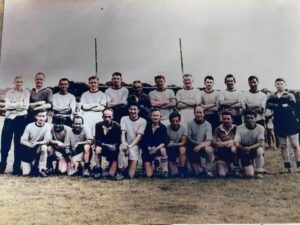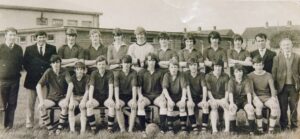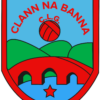The earliest documented mention of Clann Na Banna dates back to 1903, involving a friendly match that was arranged in Ballyvarley against Hurlers from Newry. Regrettably, the Newry team encountered an unfortunate incident when they were confronted by a stone-throwing Orange mob in Banbridge. This resulted in them requiring police protection for their journey back.
Various other references to Clann Na Banna’s involvement in hurling can be found in publications such as the Irish News and the Belfast Morning Star. One of these references includes a report on a friendly hurling match against Corbally Eire Og, during which the visiting team, Clann Na Banna, emerged victorious with a score of 4-6 to 3-6.
In 1913, the club’s interest in hurling was reignited, leading to the formation of a team known as “Banbridge Davitts”.
Clann na Banna quickly gained recognition for its involvement in Gaelic football. In the beginning of 1904, a fresh Clann na Banna team participated in the inaugural football championship documented in County Down. Their opponents were a team named Faugh-a-Ballagh hailing from Newry. Notably, Clann na Banna emerged victorious in this match, which was notably contested with a remarkable 17 players on each side.
The team sheet of players featured: Frank Downey (Captain), James Donnolly (goalkeeper), Tom Scott, Patrick Mulhall, William Diamond, Hugh Donnolly, Patrick Mulholland, Dan McClorey, James McCavitt, John Kinney, James Dan Kerr, and Samuel Ross.
In 1904, an important milestone was reached as Down’s inaugural participation in the Ulster Championship occurred on January 29th, 1904, in a match against Armagh. This significant encounter showcased the active involvement of nine players from Clann Na Banna.
The lineup consisted of:
Goalkeeper: James Donnolly
Defenders: Patrick Mulhall, Hugh Donnolly, T. Scott, Frank Downey, H. McCreanor, T. McCavitt
Forwards: R. Downey, William Diamond
By 1906, Clann na Banna’s secretary, John McCourt, residing at 96 Dromore Street, had officially enrolled Clann na Banna with the Down Board. Among the eight clubs registered that year, the club stood out as one of the oldest GAA clubs in Down. During this era, the club’s jerseys were notably recorded as sporting Green and Yellow Stripes, contrasting with today’s Red and Black colors.
It wasn’t until 1942 that the inaugural town-based team was established in Banbridge, with the instrumental support of Reverend Joseph O’Hagan C.C.
The first elected committee of Clann na Banna comprised:
Chairperson: Rev. Joseph O’Hagan C.C.
Secretary: Jack Mackin
Treasurer: Patrick Fitzpatrick

Committee members: Jack McGrath, Billy Byrne, Jimmy Carr, Michael Carr, Paddy Lennon, Dan and Peter McConville.
For their inaugural match, Clann Na Banna borrowed jerseys from Banbridge United, subsequently acquiring their own kit in the present-day hues of Red and Black. Reverend O’Hagan recounted the primary Gaelic football encounter in Banbridge as a “20 a side practice game in Harry McAleavey’s field.” This locale was later dubbed Cottage Park, given its adjacency to the cottage inhabited by Harry McAleavey.
During the initial ten years of the “New” Clann na Banna, the club accomplished victories in both the County Minor a Junior championship in 1944. Notably, in 1949, six members of Clann na Banna contributed to the Down team that reached the 1949 All-Ireland Junior final. These individuals were Dr. Martin Walsh, ‘Pack’ Reavey, Desy Lennon, Johnny Donaghy, Sean Herron, and Gerry McGuinness.

The 1950s marked what is often referred to as Clann na Banna’s “Golden Era.” With a growing GAA presence in Banbridge, the club orchestrated immensely successful ceilidhs and dramatic performances. During this period, an exceptionally prosperous Athletics club also emerged, solidifying its place as a prominent entity on the Irish stage.
Clann na Banna notably boasted a thriving camogie team under the formidable management of Fr. O’Hagan. In contrast, the senior men’s team experienced a decline and losy their senior status during the mid-1950s. However, by the decade’s conclusion, the club managed to clinch a junior title, guided by the leadership of Johnny Do
naghy.
Footballing talent was in abundant supply during this era, exemplified by our current President, Thomas Kennan, who captained the Down Minor side of 1958 alongside his brother Michael.
1960 saw Down lift Sam Maguire for the very first time. Clann Goalie Eamon Clements, was Sub goalie for the 1960 Down Team.
The 1970s were marked by widespread violence across Ulster, which in turn had repercussions on travel and game proceedings. This tumultuous environment often led to disruptions during matches, causing an impact on numerous fixtures. Despite these challenges, Clann na Banna’s commitment to the sport remained resolute.
In 1974, amidst these circumstances, the club persevered and clinched the Down junior championship title. This decade also witnessed the emergence of accomplished senior players, including Kevin Mur
phy, Michael Gillen, and Garvan Bradley, who excelled in high-level football competitions. Interestingly, these players have since transitioned into roles within the club’s executive committee, as well as taking on responsibilities in coaching and management capacities.
The 1980s marked a period of league restructure, leading to Clann Na Banna’s placement in Division V. Guided by the leadership of Kevin Murphy and Johnny Donaghy, the club successfully secured promotion in 1982. Throughout this era, there was a shift toward emphasizing grassroots football, manifesting through the introduction of underage teams. Notably, Collie Campbell played a pivotal role in coaching these emerging talents
.
Regrettably, despite these efforts, the club faced a setback in 1989 when it narrowly missed out on clinching a junior championship title.
As the 1990s dawned, Clann na Banna proudly fielded juvenile, minor, and reserve teams. The decade was notably impacted by an influx of enthusiastic young Gaelic players, partly driven by the Down Senior men’s team clinching two All-Ireland victories. This success seemed to invigorate both the younger and older generation of Gaels. In 1994, this renewed energy translated into a triumph as Clann na Banna secured a Minor B championship title.
By the close of the 1990s, the club was on a steady trajector
y, consistently performing well across juvenile, minor, and reserve levels. Guided by the leadership of Danny Tumilty, the senior team achieved a momentous victory by clinching the junior Championship title in 1999. This triumph was sealed with a win against Bright in the final at Castlewellan.
Furthermore, 1999 marked a historic year for Clann na Banna, as it proudly welcomed its first female Chairperson, Brenda Feeney, into leadership.
Entering a new millennium heralded another significant chapter for Clann na Banna. Fresh from their triumphant 1999 championship victory, a youthful team embarked on a journey that propelled Clann na Banna up the league rankings. In the initial half of the decade, their remarkable efforts resulted in promotion from Division Four. Simultaneously, the under-16s made their mark by securing the club’s first Division One title in many years in the South Down division.
In 2005, Micheal McAllister achieved a momentous feat, leading Down to victory and capturing a Minor All-Ireland Title as the team’s goalkeeper.
The most pivotal transformation during this era materialized in 2006, with the appointment of Tony Wilson, a native of Clonduff, as the senior manager. Tony brought with him an abundance of experience a
nd introduced a commendable level of professionalism to the squad, which was already laden with exceptional talent. Under his guidance, the team achieved promotion from Division 3 in 2006, forging an unbeaten streak that culminated in a second-place finish. As a noteworthy achievement, they concluded the decade competing in the senior championship, facing off against An Riocht in 2009. This marked the first instance in roughly half a century that the team had participated in senior championship-level football for the first time since the 1950s.
The dawn of the 2010s brought a promising start for Clann na Banna. Competing in division 2 of senior football, the club’s early years in the decade witnessed accomplishments across various age groups. Notably, the minors clinched a B championship victory by defeating Newry Bosco in the final at Saval.
The senior team experienced a series of managerial changes during this period. Michael Doyle assumed the reins in 2011, achieving a notable milestone with a semifinal appearance in the intermediate championship of 2012 – our best finish in the competition. Following his tenure, Micky Feeney and Damian Rafferty took on the joint management role. Their leadership led to a third-place finish in division 2, narrowly missing promotion. A highlight of the decade occurred in 2014 when, under the guidance of Tony Wilson, the senior team achieved promotion to division 1 – the first time in 60 years.
The decade was marked by considerable underage success as well. In 2017, our under 14s qua
lified for the All-Ireland Feile, hosted by St. Pats, Donagh, and reaching the final, narrowly falling short to a skilled Currow team from Kerry. The following year, our club hosted Feile in County Down, warmly welcoming Ballinora from Cork for a memorable weekend. This team then went on to win a division one title at under 16 level in 2019, again under the stewardship of Micky Feeney, our first since 2001.
These years marked a period of transformation for Clann na Banna, as a fresh committee emerged in 2016, replacing long-serving members. This committee undertook an ambitious fundraising campaign to address financial needs and historical debt. Unprecedented fundraising events, including a highly successful Strictly Come Dancing competition and music nights, were organized. Additionally, two prosperous Race days were held at Down Royal racecourse, substantially boosting our financial standing and enabling future planning in our development.
The decade also marked the introduction of underage ladies’ football, a resounding success that laid the foundatio
n for a thriving Gaelic 4 Girls initiative in both Clann na Banna and local schools.
Cultural revitalization was another hallmark of this decade for Clann na Banna, with participation in Scor competitions and the organization of traditional Irish music and Irish language classes.
Clann na Banna stands today as a vibrant and thriving club, boasting a membership nearing 600 – the highest in the club’s history. Notably, a Senior Ladies team has been newly established, achieving remarkable success thus far. The club provides a comprehensive footballing experience, spanning from under 6 to senior levels, catering to both male and female participants. The inclusion of Ladies football has ushered the club into a fresh, contemporary direction.
In 2022 and 2023, the club’s achievements continued as the under 14 girls secured junior league and Championship titles, alongside county and regional Feile victories.
Expanding its offerings, the club introduced recreational football for Dads and Lads, as well as G4mos, designed for the mor
e seasoned members who maintain their passion for football.
While evolving over the past century, Clann na Banna remains deeply rooted in its community ethos, a principle ingrained since its inception in 1904. With the motto “One club, one community,” Clann na Banna epitomises unity and shared purpose.







